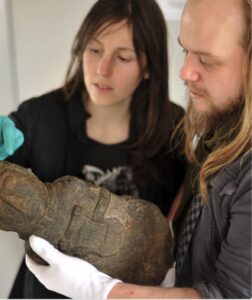Join Augustin, Alex, Lisa and the whole ArkeoTopia team to discover additional resources for step 5.6 in My Archaeology Book about identifying archaeological remains during an excavation.
Step 5.6 – Fieldwork
Identifying archaeological finds
Corresponding pages in MAB1 and MAB2
MAB 1, p. 22 (p. 23 in the 1st edition) ; MAB 2, p.28
More about the step’s reference artifact
 The drawing on pages 22 and 28 of My Archaeology Book, titled Identifying Archaeological Finds, was inspired by a fragment of a garden vase from Versailles. It is a fundamental step that allows archaeologists to find the artifacts wherever they are once they enter the reserves.
The drawing on pages 22 and 28 of My Archaeology Book, titled Identifying Archaeological Finds, was inspired by a fragment of a garden vase from Versailles. It is a fundamental step that allows archaeologists to find the artifacts wherever they are once they enter the reserves.
 In addition to photographing the remains and making a drawing, archaeologists must go through another step: identification. By identifying each remains, the archaeologists leave a mark called an excavation number. It is this number that will provide other fellow archaeologists, scientists and museum curators with information about the origin and destination of the remains and will also make it possible to follow the life of the remains from the field (excavations, donations from a person, inventories…) to the museum.
In addition to photographing the remains and making a drawing, archaeologists must go through another step: identification. By identifying each remains, the archaeologists leave a mark called an excavation number. It is this number that will provide other fellow archaeologists, scientists and museum curators with information about the origin and destination of the remains and will also make it possible to follow the life of the remains from the field (excavations, donations from a person, inventories…) to the museum.
An excavation number cannot be invented in a few seconds. It is information that is well thought of before the excavation or the inventory. Indeed, it must be both simple and effective: simple so that it can be directly noted on the remains and effective so that it can be easily understood.
 In this step, the sherd of vase discovered by Annick Heitzmann and Adeline Bats in 2008 (in French) in the embankments of the bosquet de la Reine at Versailles helps making this stage clear. Lisa the archaeologist writes the excavation number Vers.F18.6.2008 on the blue and white earthenware ceramic with a rotring, or a fountain pen which allows to mark with ink useful information on the label. This excavation number, or inventory number, allows us to know that this sherd was found in Versailles in June 2008 and corresponds to the number F18 of the finds made at that time. It is a number invented to be as explicit as possible to young people.
In this step, the sherd of vase discovered by Annick Heitzmann and Adeline Bats in 2008 (in French) in the embankments of the bosquet de la Reine at Versailles helps making this stage clear. Lisa the archaeologist writes the excavation number Vers.F18.6.2008 on the blue and white earthenware ceramic with a rotring, or a fountain pen which allows to mark with ink useful information on the label. This excavation number, or inventory number, allows us to know that this sherd was found in Versailles in June 2008 and corresponds to the number F18 of the finds made at that time. It is a number invented to be as explicit as possible to young people.
Clues
The 4 clues include:
- The landscape represents the Palace of Versailles which serves to understand where the remains were discovered.
- The sherd of vase of less than 20 cm dating back to the XVIIIth century held by the hand of Lisa the archaeologist, which corresponds to the remains which need to be identified, that need to be identified, that is to say, to be marked to know where it was extracted from and when.
- The rotring which to mark with ink useful information on the label.
- The label noted Vers.F18.6.2008 which allows presenting the identification information.
Taking PicturesMy Archaeology Book
Resources HomepageStep 6.1 – In the Lab
Use-Wear Analysis






